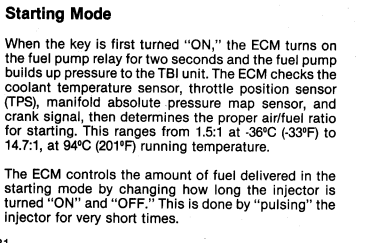Contributor
Well-known member
- Joined
- Jul 9, 2022
- Posts
- 1,423
Here is a YouTube troubleshooting your same issue on a 1992 RV with the 454. Pretty good guide.
The more I think back on the reverse polarity situation that started this whole thing, the more I tend to agree with him about the ECM.Careful, be sure there isn't some other input missing like maybe a crank sensor that's inhibiting the injectors. You can throw parts at it and you can get lucky sometimes, but if you're not sure it's the ECM all you're doing is saving the troubleshooting time for later when the new one has the same symptoms as the old.
Mark B.
Albuquerque, NM

The flash code I was really looking for a code 12, which would indicate that the ECM is alive.The "flash codes" you can get by jumpering the test mode pins on the ECM I'm not sure would reveal much since with all the electrical mayhem going on here I'd say any codes stored would be arbitrary. But, if it flashes anything at all it's an indicator it's "alive" and unless it does otherwise I'd still be checking inputs and sensors. My last throttle body car "died" and it turned out to be several sensors that went bad and I didn't know it because the car ran fine, until it didn't. Turns out that the ECM can disregard wildly erroneous values of a few failed sensors until enough data goes bad it can no longer "guess" what it should be doing. The only errors or failures that are required to trip the CEL are emission related so I discovered you can have enough wrong with the engine it won't run, but still not set the CEL. Fortunately even though it was a pretty intelligence limited ECM of the day it blinked out enough codes I was able to chase everything down.
Mark B.
Albuquerque, NM
If you said I forgot. What year is the chassis/engine. Many MH's are built on a chassis the MH mfgr. purchases the prior year, I've read of a few MH's on a 2 yr old chassis.I got a really strange question
I have a fuse marked (crank) but according to the books I have a 1990 does not have a crank sensor (96 0r newer only).
What am I missing
The news today is not too good.
I disconnected the fuel line at the carb and sure enough when i turned the key I did have fuel.
That means the injectors are not firing. I really don't know the procedure for testing them.
I do not have a Noid light and I tried the 9-volt battery trick with no results. That means either the injectors are bad, or the battery was to week to work.
I wrote down the numbers on the ECM, but they must be wrong because nothing comes up when I search for those numbers.
As far as I can tell there are a couple of switches left to check but I am not sure which way to turn.
ECM is around $100, and the injectors are at least $150 for a pair, and I really don't want to just throw parts at it.
Thank you for your patience with me
